Notes
Visual Blindspots and Media Bias: The “Disappearing” of Kamala Harris
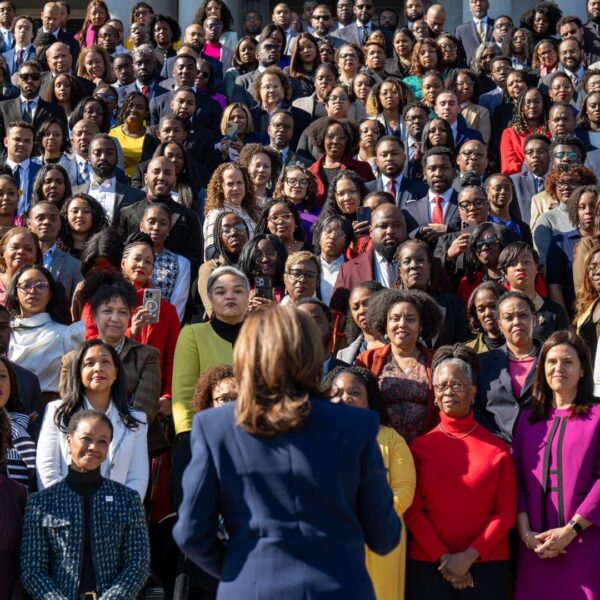
“As we wrap up Black History Month, let’s continue to honor and celebrate our history—the history of Black excellence and leadership, culture and creativity, resilience and resistance. We celebrate Black history as America’s history, not just this month but every month.” February 29, 2024, photo via @KamalaHarris on X.
While the media frames Kamala Harris as “missing-in-action,” she has tackled the hardest jobs and is everywhere fighting for social justice. Just look at the pictures.
Joe Biden’s State of the Union speech not only allowed him to show he still knows what’s what but also gave the national audience a look at Kamala Harris. Sitting behind Biden and cheering him on, did the glimpse remind the country that she’s a force to be reckoned with? Or how she has brought so much energy and consciousness to the White House, not to mention a wealth of visually compelling moments? Far from it. Despite all she has done, charges of invisibility and ineffectiveness tend to define her reputation in the media landscape.
Contrary to this narrative, reality tells a different story.
From the moment she was elected as America’s first female, first Black, and first South Asian Vice President, Kamala Harris has faced a paradoxical existence in media coverage. She is simultaneously hyper-visible as a historic “first,” yet often rendered invisible regarding her substantive policy work and longstanding activist profile.
Taking on the Hardest Jobs
Media coverage tends to emphasize critiques of her handling of thorny assignments. Still, many of Harris’ most high-profile roles have been in areas where any progress is Sisyphean – where the odds are long and the political headwinds fierce. Harris has led the administration’s efforts to strengthen access and combat the wave of restrictive laws on voting rights. Her immigration reform work has been stymied by congressional gridlock and a broken system desperately needing an overhaul.
In these “no-win” scenarios, Harris is set up to be criticized no matter what. Make progress? It’s not enough. Fail to move the needle? She’s ineffective. The media narrative is often decided before she ever takes the field.
The MIA Rhetoric
That is the gist of this photo illustration and the “nothing to show for herself” headline from an article in The Week last May. Besides the picture of Harris looking askance, these volatile issues are like a sickly shadow; the headline plays on the “lack of achievement” narrative, notwithstanding the more sympathetic subhead.
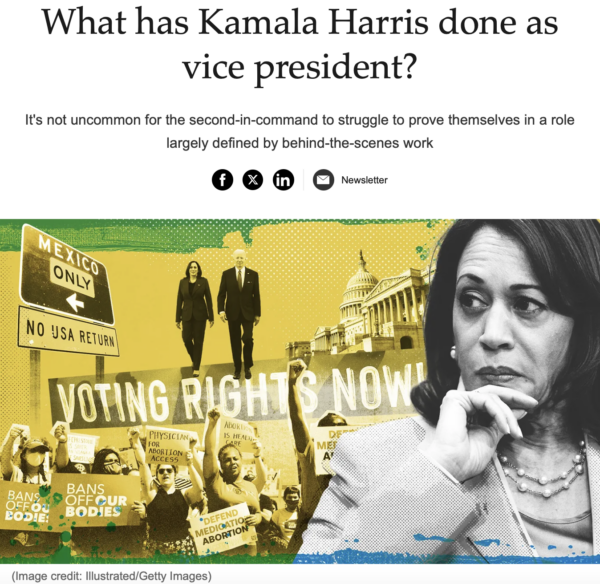
The title of this October 2023 New York Times Magazine cover article, perhaps the most prominent examination of Harris’s V.P. tenure to date, drives home the same missing-in-action meme.
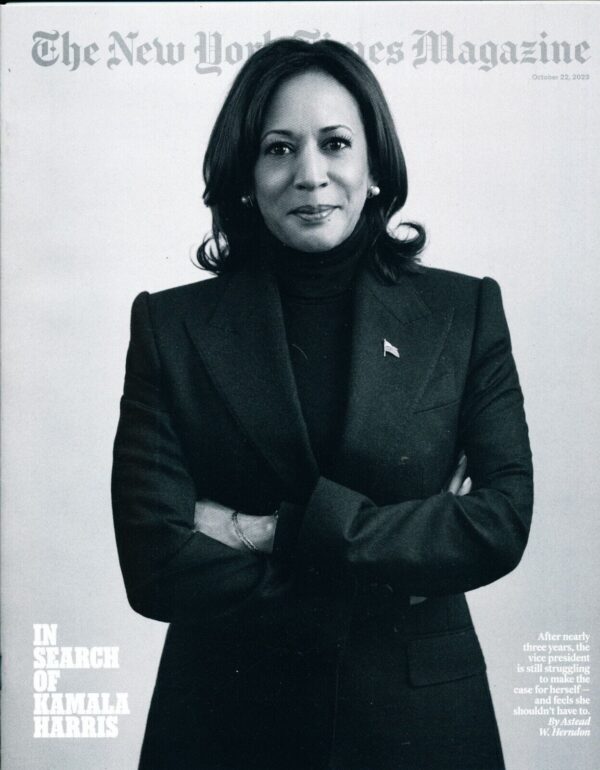
Photo: Djeneba Aduayom for The New York Times
The “shame me, then blame me” anchor text is even more toxic.
After nearly three years, the vice president is still struggling to make the case for herself – and feels she shouldn’t have to.
The first part of the sentence lays down the “nothing to show” charge and dares to make it personal: Harris has nothing to show for herself instead of her effort. Then, putting the onus on her to answer the charge, it calls her out for rejecting the hostile premise.
With this toxic narrative, the text takes an otherwise bright and outgoing photograph, Harris’s arms crossed in confidence, and infects it with the allusion of stubbornness and self-deception.
Variations on a theme: Note this photo, which also ran in the article, and the shame of another caption.
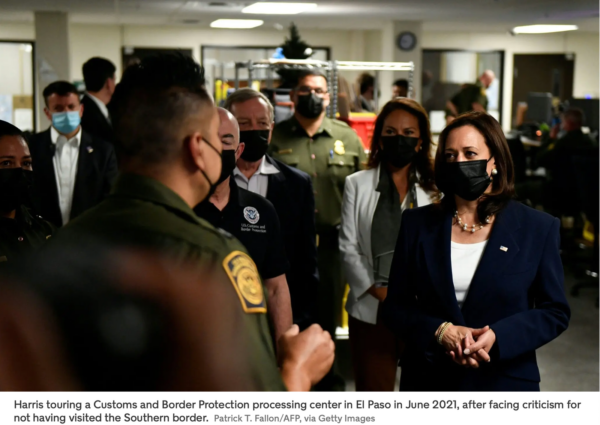
Disparaging Harris’s visit as simply face-saving, the photo edit is also gendered, as Harris, muted by the mask and gripping her hands, could be seen as mansplained by the officer.
Activism Profile
While the media has rightly highlighted Harris’ barrier-breaking role, they’ve given short shrift to her activism and advocacy, starting from her youth. In the Senate, she forcefully pursued racial equity, prison reform, LGBTQ+ rights, and reproductive freedom.
What doesn’t get said out loud in the mainstream is that her policy role puts Kamala Harris front and center in the culture war. In the face of the country’s rightward tilt and the persistent assault on the rights of women, immigrants, people of color, gender identity, and other social justice issues, Harris has become a lightning rod.
What makes matters worse, specifically for a strong Black woman, is that, besides being a policymaker and Biden’s leading ambassador, she has maintained her role as a change agent, using her office as a pulpit to empower and rally.
It’s easy to neglect or demean Harris as a “do nothing” or MIA when her prodigious effort is explicitly focused on the politics of inequality and dispossession. It’s not far-fetched to assume that if Harris was a politician in the MAGA realm or even a white liberal, her activism might earn its share of critique, but the media would accept it as her brand.
Not Nowhere But Everywhere
Harris’s agenda and attempt to bring visibility and agency to the disenfranchised explodes the notion that she has been missing or ineffectual. On the other hand, how her “mission” threatens not only the right wing but also the status quo engenders her disenfranchisement.
This is where the pictures come in. In contrast to the narrative that she has been missing in action, Harris has been anything but.

“Young leaders are driving change on campus, in their communities, and around our country. That’s why I am excited to hit the road for my Fight For Our Freedoms College Tour, hear directly from students, and work alongside them in the fight for our rights.” Via @VP on Instagram
The Visual Record
Examining the visual record of Harris’s engagements offers a compelling counter to the media narrative. Below, I’ve drawn on the rich imagery from Harris’s social media, including the accomplished work of Vice-Presidential photographer Lawrence Jackson, as a counterpoint to what we do and don’t see in the picture painted of her.
Racial Equality
The most recent and ironic commentary on Harris’s “invisibility” occurred two weeks ago after Harris helped commemorate the 59th anniversary of Bloody Sunday at the Edmund Pettus Bridge, which Biden also referenced in his State of the Union speech on the actual anniversary.
Did you happen to see any photos? This image, one of two, led The Guardian’s Photos of the Week.
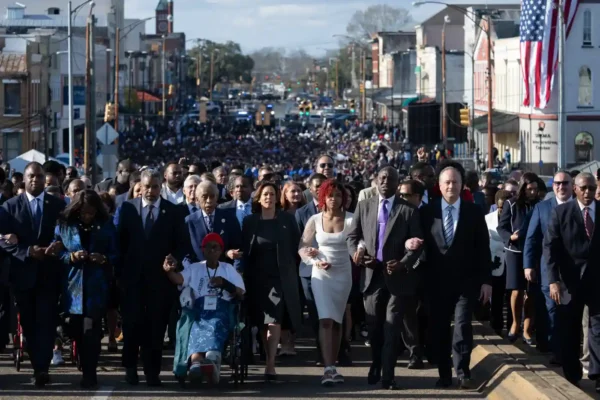
U.S. Vice-president Kamala Harris joins a march across the Edmund Pettus Bridge on the 59th anniversary of Bloody Sunday in Alabama. On March 7, 1965, civil rights marchers crossed the bridge and clashed with state police, who used batons and teargas to disperse the protesters. Photo: Saul Loeb / Getty Images
Women’s Health and Reproductive Freedom
No issue has been more critical to Harris. She has been a constant blur of activity, rallying citizens and legislators to challenge and roll back the restriction on women’s access to reproductive services.
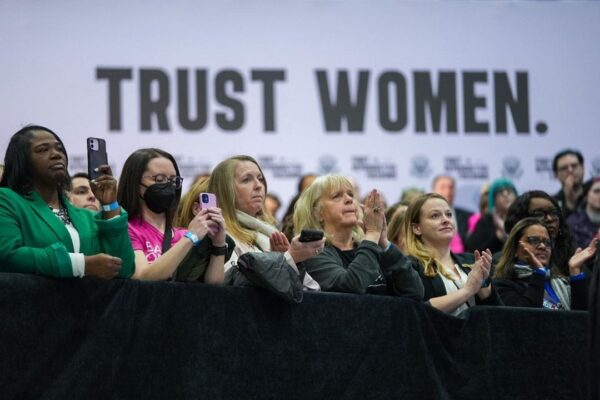
Women across our nation face a healthcare crisis as extremists ban abortion, endanger women’s lives, and criminalize doctors. Today, I was in Wisconsin to tell the women of America: We see your strength, we are listening to your stories, and we are with you. January 22, 2024.
Just last week in Minnesota, Harris became the first sitting President or Vice President to visit an abortion clinic. Despite the bold move, the media attention was perfunctory, and the accompanying images were mostly podium shots. In contrast, the picture below conveys the intimacy and moral support these workers deserve, which Harris delivers.

While in the Twin Cities yesterday, I thanked healthcare professionals at the front of our fight for reproductive freedom. They dedicate themselves to providing care for the women of Minnesota, as well as those from states with extreme abortion bans. March 14, 2024. @vp Instagram
Identity and Empowerment
Since day one on the job, Harris has actively inspired those from marginalized communities and diverse racial, ethnic, and cultural backgrounds, with a special focus on the young.
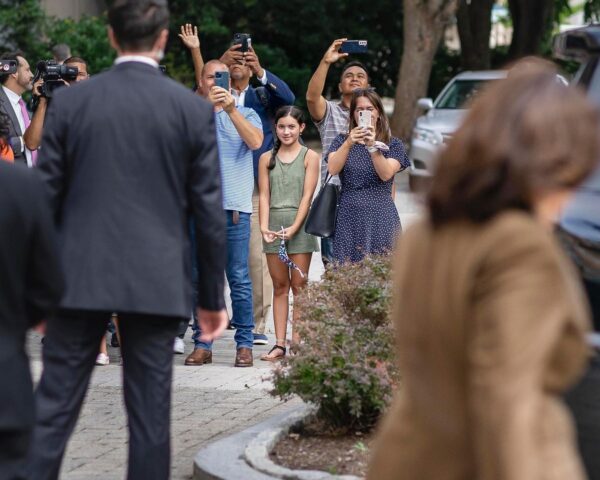
A young girl watches Kamala Harris leave a meeting with Texas State Representatives on July 13, 2021. Photo: Lawrence Jackson @jackimages on Instagram
The photo below exemplifies how often Harris’s outreach simultaneously embraces race, ethnicity, gender, class, and opportunity.

On International Women’s Day, I am thinking of the women and girls I have met while traveling as Vice President. I tell them: Dream with ambition. Lead with conviction. And know that you can do anything, even if it hasn’t been done before. March 9, 2024. @vp Instagram
Gun Violence, Hate Crime, Police Misconduct
Harris has been an aggressive advocate for gun control and the fight against all forms of domestic terror.
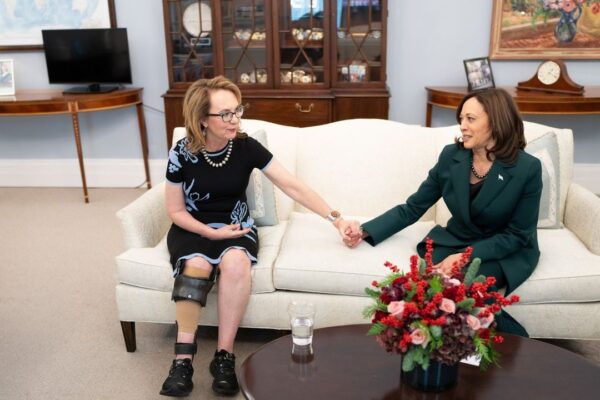
“Gabby Giffords’ courage and leadership is an inspiration for everyone in the movement. It was my honor to spend time with her and gun safety advocate Trevon Bosley today to discuss our continued work to end gun violence.” Via @VP on Instagram
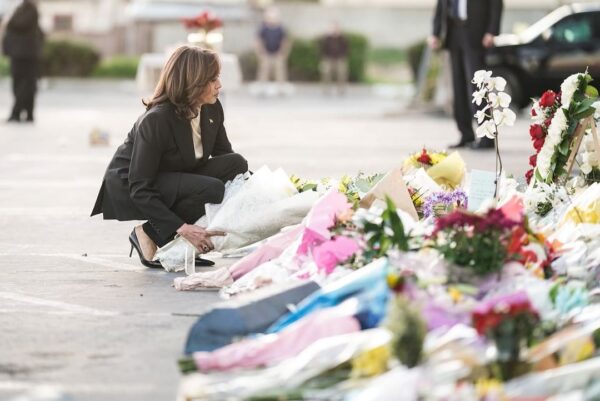
5:10 pm. Wednesday, January 25, 2023, Monterey Park, Calif. @vp lays flowers at the site of the mass shooting that killed 11 people at a local dance studio. She later talked to the press about the need for better gun control laws. Photo: Lawrence Jackson @jackimages on Instagram
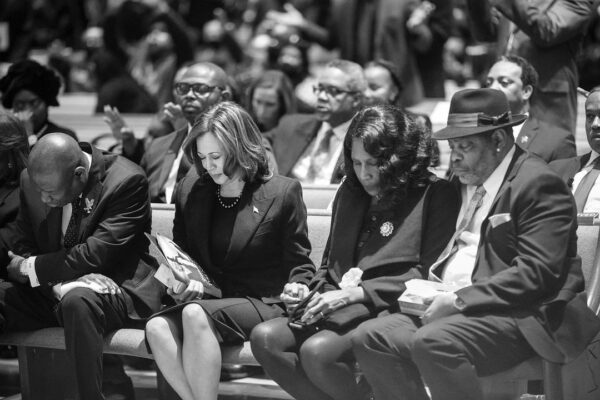
3:07 pm, February 1, 2023, at the Mississippi Boulevard Christian Church in Memphis, Tennessee. @vp prays with Row Vaughn Wells and Rodney Wells, mother and stepfather of Tyre Nichols, at his funeral service. Tyre died on January 10 from injuries he sustained from five Memphis police officers. Photo: Lawrence Jackson @jackimages on Instagram
Labor and Opportunity
I should add that, for an activist like Kamala Harris, all these group portraits function less as an individual showcase and more as a recognition of the collective movement. They capture the meeting itself, providing visibility and equity to all those involved. The focus shifts from a single leader to the diverse voices driving social change through unity and shared purpose.
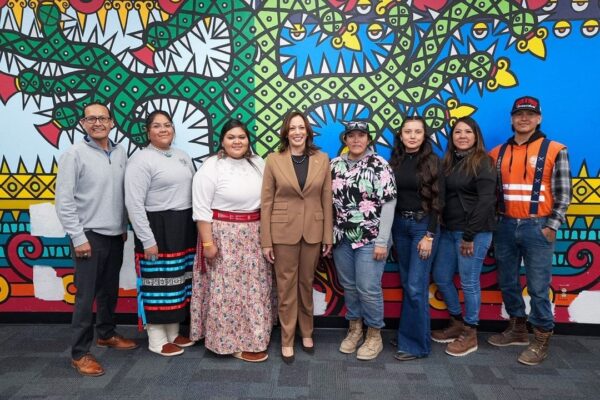
Last week, I thanked Navajo members of Ironworkers Local 75 for their work on the construction of semiconductor chip facilities in Arizona. President Biden and I are creating jobs and boosting American Innova through the CHIPS and Science Action. Posted March 13, 2024. Via @VP Instagram

While visiting the Chef Jeff Project in Nevada, I announced that @sbagov loans will soon be open to people with criminal records, helping entrepreneurs gain access to capital and reach their full potential. After the three strongest years of small business growth on record, we are continuing to build an economy that works for all people and all communities. January 30, 2024. @VP Instagram
On the grand stage of American politics, Vice President Kamala Harris’s tenure is a complex thread of unenviable challenges and steadfast activism, often obscured by media bias. As she navigates the tightrope of public service, her story is not just one of political trials but a broader commentary on the narratives we craft about our leaders. It is a call to recognize the intricate dance between power and perception and to demand a media landscape that does justice to the full spectrum of her effort.

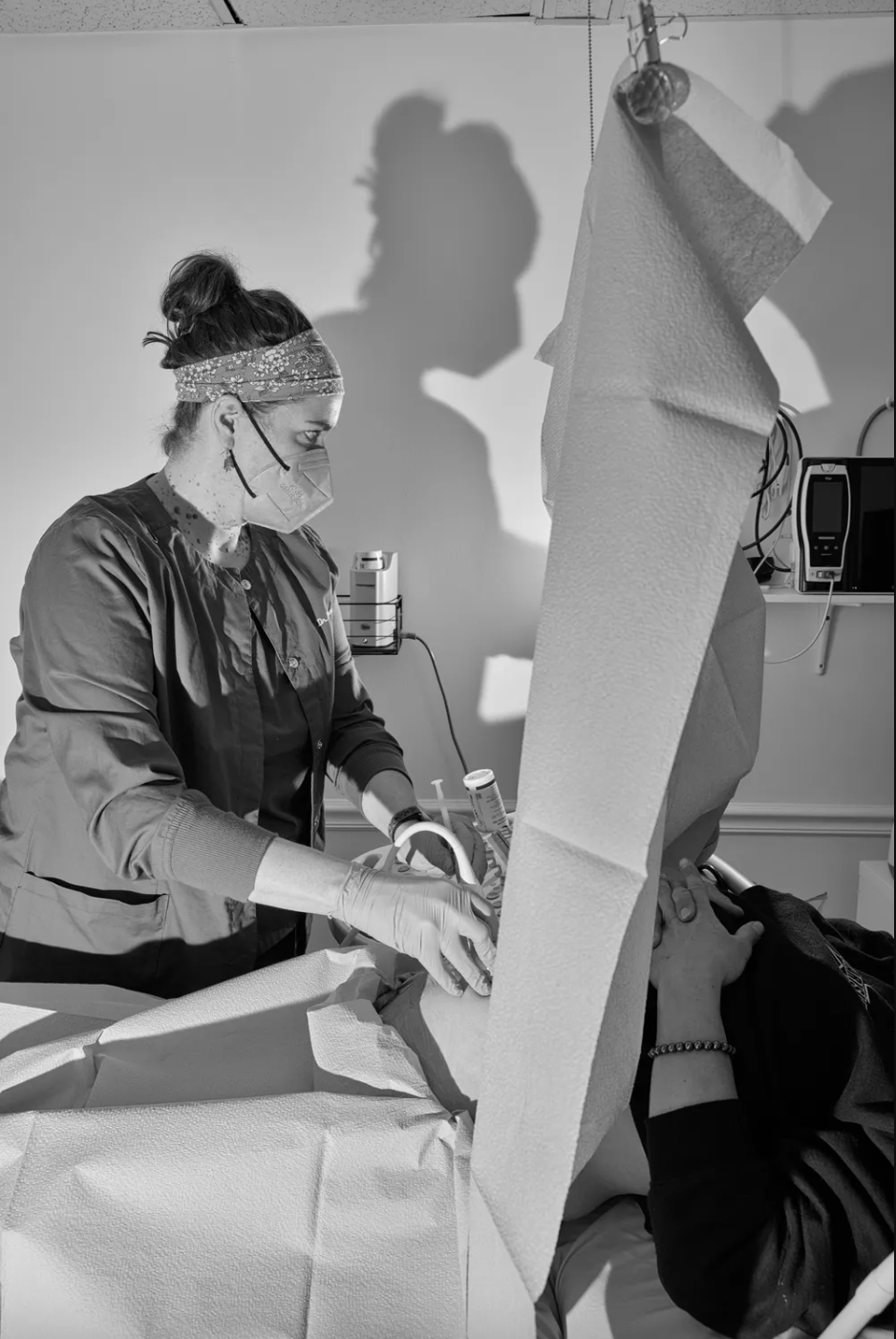
Reactions
Comments Powered by Disqus